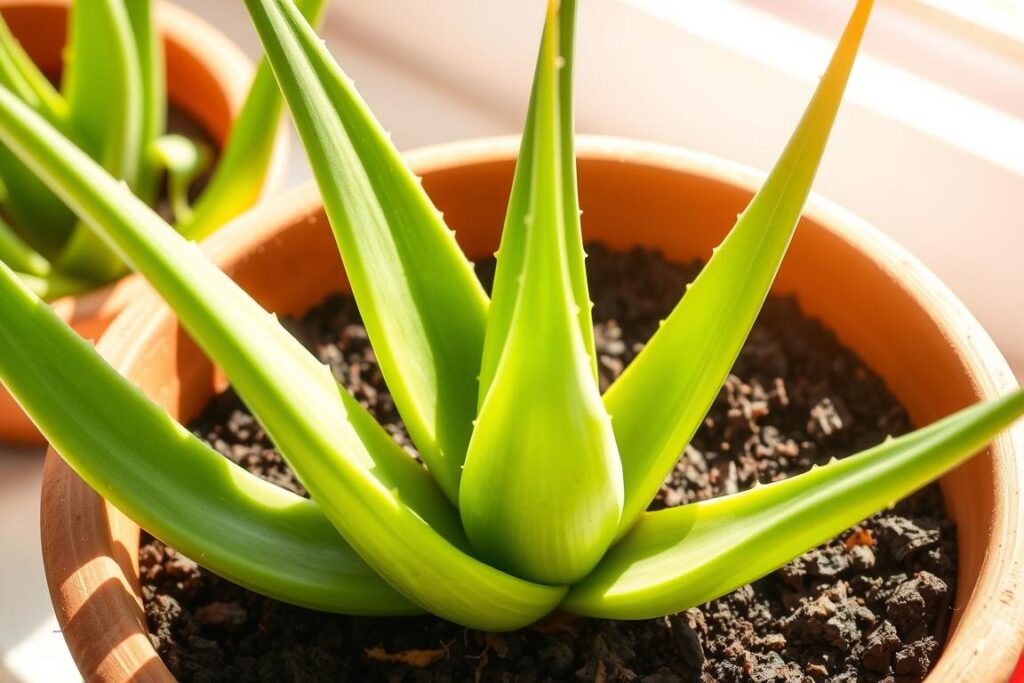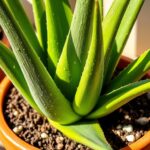I recently repotted my aloe vera plant. I wondered, “What now? How can I make sure it thrives?” Many plant lovers ask this. I’m here to share what I learned.

Repotting an aloe vera is key for its growth. It needs a bigger pot to grow well. But, there’s more to do after repotting. We must care for it to grow lush and vibrant.
Key Takeaways
- Allow the aloe vera plant to settle in the new pot for 5 to 7 days after repotting
- Maintain a consistent watering schedule and monitor soil moisture levels
- Provide the plant with the right lighting conditions and temperature range
- Be patient and allow the aloe vera time to establish its roots in the new pot
- Fertilize the plant after it has had a chance to settle in its new home
Understanding the Importance of Proper Post-Repotting Care
Proper care after repotting is key for your aloe vera plant’s health. When you move it to a new pot, it needs special care. This care helps your aloe vera plant thrive and avoid problems.
Why Post-Repotting Care Matters
Repotting is stressful for aloe vera plants. Being moved and having its roots exposed can shock it. Good care after repotting helps it adjust and grow well.
Common Challenges After Repotting
One big problem is overwatering. The roots are weak and can rot easily. Also, the right light is crucial. Aloe vera needs bright, indirect sunlight.
Transplant shock can make leaves wilt or change color. This needs careful attention.
Setting Expectations for Recovery
Aloe vera plants need 1-2 weeks to recover after repotting. They focus on growing roots in the new soil. Be patient and gentle to help them heal.
What Should I Do After Repotting My Aloe Vera Plant
Congratulations on repotting your aloe vera plant! Now, focus on post-repotting care. This ensures your plant grows well in its new home. Here’s how to help your aloe vera start strong.
First, put your aloe vera in a bright spot but not in direct sunlight. Direct sunlight right after repotting can stress the plant and make it wilt. The right light helps your aloe get used to its new spot.
- Wait 5-7 days before watering again. Don’t water it during this time. It needs to recover from repotting.
- Watch your aloe vera for signs of stress or wilting. If leaves start to droop or change color, adjust your care.
- Make sure your aloe vera is in a potting mix made for succulents and cacti. This prevents root rot, which is bad for the plant.
By following these steps, you’ll help your aloe vera start strong in its new home. Remember, patience and careful care are important for a good recovery.

“Aloe vera plants are known for their healing properties, and with the right care, they can thrive for years to come.”
Creating the Ideal Recovery Environment
After repotting your aloe vera, it needs more than just a new home. You must create the perfect spot for it to grow well. We’ll look at temperature, light, and humidity.
Temperature Requirements
Aloe vera likes it warm, between 55-80°F (13-27°C). Keep it in a spot that stays warm. This helps it recover and grow strong roots.
Lighting Conditions
Alloe vera needs bright, indirect light. It can handle some sun, but too much is bad. Place it where it gets lots of aloe sunlight requirements but not direct sun in the afternoon.
Humidity Considerations
Alloe vera likes dry air, not too wet. Make sure it has good air flow. This stops fungal problems from too much moisture. Don’t spray water on the leaves to avoid issues.
With the right aloe soil conditions, temperature, light, and humidity, your aloe will recover well. It will grow strong and healthy after repotting.
Watering Schedule for Newly Repotted Aloe
Caring for your aloe vera plant after repotting is very important. It helps the plant grow well. Knowing the right aloe watering schedule is key.
Wait 5-7 days before watering your aloe after repotting. This lets the plant adjust and the soil settle. After that, water when the top 1-2 inches of soil are dry.
- In summer, water every 10-14 days.
- In winter, water every 14-21 days.
Letting the soil dry out between waterings is crucial. This prevents root rot, a big problem for succulents like aloe. Avoid overwatering to keep your aloe healthy.
| Season | Watering Frequency |
|---|---|
| Summer | Every 10-14 days |
| Winter | Every 14-21 days |
Be patient and watch your aloe’s soil moisture. Following this aloe watering schedule will help your plant grow strong.
Monitoring Root Development and Growth
After you repot your aloe vera, watch its roots and growth closely. This helps the plant adjust to its new home. It also spots any problems early.
Signs of Successful Root Establishment
Look for these signs that your aloe vera’s roots are doing well:
- New leaves growing from the plant’s center
- The plant stays firm and doesn’t wobble
- The soil stays moist for a while before needing water
Identifying Potential Root Problems
Watch for signs of root trouble, like:
- Yellow or wilted leaves, which might mean root rot
- A bad smell from the soil, which could be root decay
- The plant feels loose in its pot, showing weak roots
Recovery Timeline Expectations
With good aloe vera care and plant aftercare, your repotted aloe vera will recover in 4-6 weeks. Be patient and keep an eye on it. Adjust its care as needed.

Watching your aloe vera’s roots and growth closely helps it recover well after repotting. With care, it will flourish in its new spot.
Adjusting Light Exposure for Repotted Aloe
After you repot your aloe vera, slowly add more light over 1-2 weeks. Aloes love bright, indirect sun. So, put the plant in a sunny spot but not too close.
Don’t let the aloe get too much sun. It can burn the leaves. If leaves start to fade or turn yellow, it’s getting too much light. Move it to a bit shadier place.
Finding the right light balance is key. Gradually increase the light and watch how the plant does. This helps it recover well after repotting.
| Aloe Sunlight Requirements | Ideal Conditions |
|---|---|
| Bright, indirect sunlight | Southern or eastern exposure, in front of a window |
| Avoid direct sunlight | Can cause leaf burn and damage |
| Monitor for pale or yellowing leaves | Move plant to a slightly shadier spot |
Follow these tips for aloe sunlight requirements after repotting. This helps your aloe vera plant grow strong and healthy. Good plant aftercare is crucial for its long-term health.
Fertilization Guidelines After Repotting
Caring for your aloe vera plant doesn’t stop after repotting. Fertilizing right is key for its recovery and growth. Here are the tips for fertilizing your aloe after repotting.
When to Start Fertilizing
Wait 1-2 months before starting to fertilize your aloe vera plant. This lets the roots settle in the new soil. Fertilizing too soon can stress the plant.
Choosing the Right Fertilizer
For aloe vera, use a balanced, water-soluble fertilizer. Look for an NPK ratio of 2-4-8. This supports the plant without harming it. Stay away from high-nitrogen fertilizers.
Application Methods
In spring and summer, fertilize every 4-6 weeks. Dilute the fertilizer to half strength to avoid root burn. Apply it to moist soil for better absorption.
Don’t fertilize in winter when the plant grows less. Fertilizing then can stress the plant.
By following these aloe fertilization tips and giving your plant the right plant aftercare, it will recover well. Your aloe vera will stay healthy and strong.
Managing Common Post-Repotting Issues
After repotting your aloe vera, watch it closely. Leaf drooping means you might need to change how you water it. If leaves turn brown or get spots, it’s too sunny. Move it to a shadier spot.
Pests can be a problem after repotting. Look for webbing or discolored leaves. Use neem oil to treat it. Follow the instructions and don’t overwater to avoid root rot.
If your aloe vera doesn’t get better in 2-3 weeks, check the roots. Look for rot or damage. If needed, repot it again with fresh, draining soil for its health.
FAQ
What should I do after repotting my aloe vera plant?
After repotting, give your aloe vera the right care. Pick the right pot and soil. Follow the steps to repot correctly.
Let the plant rest for 5-7 days. Then, go back to your usual care routine.
Why is post-repotting care important for aloe vera plants?
Good care after repotting helps your aloe vera plant. It lets the plant adjust and grow well. Watch out for problems like too much water and not enough light.
What should I do in the first few days after repotting my aloe vera?
Put your aloe vera in a bright, indirect light spot. Don’t water right away. Wait 5-7 days to start watering again.
Check the plant for stress signs. Make sure the soil drains well and use the right potting mix.
What are the ideal environmental conditions for a repotted aloe vera?
Aloe vera likes temperatures between 55-80°F. It needs bright, indirect light. Keep humidity low and air flowing well.
How often should I water my aloe vera after repotting?
Wait 5-7 days before watering. Water when the top soil is dry. Water more in summer, less in winter.
Always let the soil dry before watering again to avoid root rot.
How can I tell if my aloe vera has successfully established its roots after repotting?
Look for new leaves and stable plant growth. Yellow leaves or bad smells mean root problems. Expect full recovery in 4-6 weeks.
How should I adjust the light exposure for my repotted aloe vera?
Slowly increase light over 1-2 weeks. Place it in bright, indirect light. Avoid direct sun to prevent burn.
If leaves get pale, move it to a shadier spot.
When should I start fertilizing my aloe vera after repotting?
Wait 1-2 months before fertilizing. Use a balanced fertilizer at half strength. Fertilize every 4-6 weeks in spring and summer.
Don’t fertilize in winter when it’s slower.
How do I address common issues with my repotted aloe vera?
Fix droopy leaves by adjusting water. Brown spots mean less sun. Pests need neem oil treatment.
If problems last 2-3 weeks, check for root rot. Repot with fresh soil if needed.






